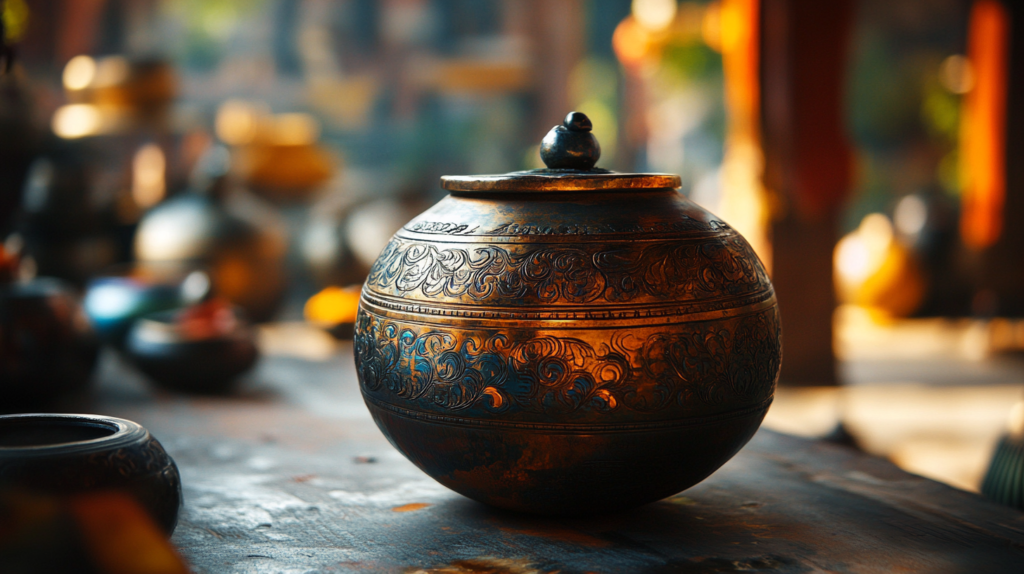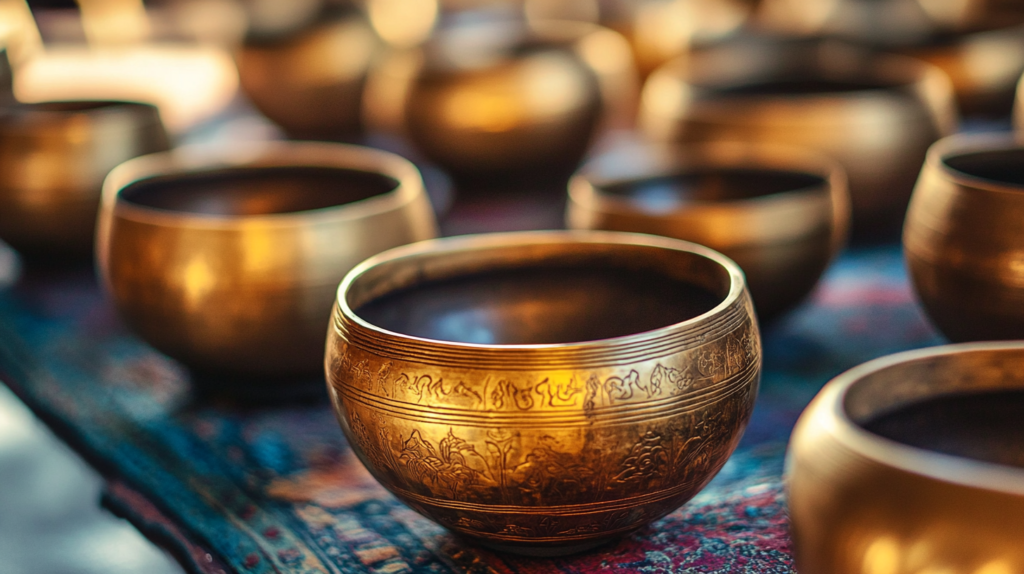As someone who has been working with Tibetan singing bowls for over 40 years, I’ve seen firsthand the incredible impact these powerful tools can have. From soothing the mind to healing the body, they’ve been a cornerstone in my personal and professional life. Now, I’m at a point where I want to share what I’ve learned with others, guiding you through the process of choosing the right bowl to fit your needs. Whether you’re new to the world of sound bowl meditation or a seasoned practitioner, this guide will help you navigate the process of selecting the perfect Tibetan bowl.

Tibetan singing bowls, also known as Tibetan musical bowls, have been used for centuries in meditation and healing practices. These instruments are traditionally made from a blend of metals, each representing different planetary energies. When struck or played with a mallet, the bowls produce harmonic tones and vibrations that deeply influence the mind and body.
Scientifically, the healing properties of these bowls stem from the frequencies and vibrations they create. Sound therapy with Tibetan bowls is thought to influence the brain by synchronizing brainwaves, helping individuals enter meditative or trance-like states. This can result in reduced stress, enhanced relaxation, and even physical healing. The sound waves produced by the bowls also resonate through the body, recalibrating energy fields and promoting balance in both emotional and physical well-being.
In fact, recent studies, including those published in the National Institutes of Health (NIH), suggest that sound healing with these bowls may help reduce anxiety, pain, and depression by activating the parasympathetic nervous system, thereby promoting relaxation and recovery.
Understanding the Basics: What Is a Tibetan Singing Bowl?
Before diving into the details, it’s important to understand what a Tibetan singing bowl actually is. These bowls are ancient instruments, traditionally made from an alloy of various metals, including copper, silver, iron, and gold. They create harmonic overtones when struck or played with a mallet, producing vibrations that are thought to influence both the body and mind.
The beauty of these bowls lies in their simplicity. Whether it’s a Tibetan musical bowl, a Tibetan prayer bowl, or a Tibetan gong bowl, each type resonates with different tones and vibrations, which can deeply impact your physical, mental, and emotional well-being. This is why they’re often used in practices like sound bowl meditation and sound baths—therapies that allow the listener to bathe in the healing vibrations of the bowls.

Key Factors to Consider When Choosing a Tibetan Bowl
With so many different types and styles available, finding the perfect Tibetan singing bowl can be overwhelming. However, there are several key factors you should keep in mind:
1. Material Composition
The metal composition of your bowl is crucial. Traditional Tibetan bowls are made from an alloy of seven or more metals, each representing a different planet in ancient Tibetan cosmology. The blend often includes gold, silver, copper, iron, and tin. However, more modern bowls may be made from fewer metals, and while they might still produce lovely sounds, they might not have the same depth of vibration.
From my experience, bowls that adhere closely to the traditional metal blend tend to produce richer, deeper tones. These bowls resonate at lower frequencies and have longer sustain, which is especially important if you’re using them for meditation or healing practices.
2. Bowl Size: Does It Matter?
Absolutely. The size of your Tibetan singing bowl directly influences the tone and frequency it produces.
- Small Bowls (10-15 cm): These produce higher-pitched tones and are more portable. They are ideal if you’re traveling or if you plan to use the bowl in sound bath sessions with other instruments. I find that small bowls work best when you’re focused on clearing energy from your upper chakras, as they resonate with lighter, more ethereal tones.
- Medium Bowls (15-25 cm): If you’re looking for versatility, this is your size. Medium bowls produce a balanced mix of high and low tones and are perfect for daily singing bowl meditation. They are great for grounding practices as well as emotional healing.
- Large Bowls (25 cm and above): Larger bowls create deeper, more resonant sounds. These are ideal for sound therapy and full-body healing. The vibrations from larger bowls are so powerful that you can actually feel them reverberate through your body, which is why they’re often used for deep relaxation and chakra balancing.
3. Sound and Tone
One of the most critical aspects of choosing a Tibetan singing bowl is the sound it produces. When played correctly, a bowl should produce a tone that feels harmonious and natural to your body. Different bowls resonate at different frequencies, and you’ll find that certain tones feel more calming or energizing than others.
In my own experience, I’ve learned that there’s no substitute for testing out the bowl in person. If that’s not possible, you can often find sound clips online. Pay attention to how the sound makes you feel. Does it calm you? Energize you? The best bowl will resonate with your energy and needs, so trust your intuition when listening.
4. Purpose: Meditation, Healing, or Both?
Think about why you’re buying a Tibetan musical bowl. Are you looking for a tool to aid in your meditation practice, or are you hoping to use it for sound healing? While all bowls can be used for both, certain sizes and frequencies are better suited for specific purposes.
- For Meditation: Medium to large bowls with a deep, steady resonance work best. The sound helps quiet the mind and enter a meditative state.
- For Sound Healing: Larger bowls are generally more effective for full-body healing, as their vibrations can be felt more profoundly in the physical body.
5. Aesthetic Appeal
While sound is the most important factor, let’s not forget about the aesthetic beauty of Tibetan bowls. These bowls are often adorned with engravings or symbols, representing Buddhist or spiritual concepts. Some bowls are plain, while others feature intricate designs, including mantras or depictions of deities.
Personally, I find that having a bowl with an aesthetic that resonates with me makes the experience of using it even more powerful. However, aesthetics are a secondary consideration to sound and purpose.
6. Origin and Craftsmanship
The origin of your Tibetan bowl matters. Authentic bowls from Nepal or Tibet are handcrafted using traditional methods. These bowls tend to have a richer history and higher quality. Be wary of mass-produced bowls, often made in factories outside of the region, which may not carry the same depth of craftsmanship or sound quality.
When I first started using Tibetan singing bowls, I didn’t think much about where they came from. But as I’ve learned more, I now seek out authentic, hand-beaten bowls from artisans who are continuing this ancient tradition. Supporting these artisans not only ensures you’re getting a quality product but also helps preserve the cultural heritage of the practice.

7. Mallet Material
Though it may seem like a small detail, the mallet you use can also affect the sound of your Tibetan gong bowl or Tibetan prayer bowl. Mallets come in different materials, including wood, felt, and leather. Wooden mallets tend to create a brighter, sharper sound, while mallets with felt or leather coverings produce a softer, warmer tone.
The Spiritual Connection: How Tibetan Bowls Enhance Meditation and Healing
At this stage in my life, I’ve come to see Tibetan bowls as more than just instruments—they’re spiritual tools that guide me through deeper levels of awareness. Whether used in a sound bath bowl session or in daily meditation, the act of engaging with these bowls brings me back to the present moment, grounding me in my practice and in life.
Sound bowl meditation has been one of the most rewarding practices I’ve embraced. The sound waves from the bowl help synchronize brainwaves, inducing a meditative or trance-like state. For me, it’s an experience of letting go, allowing the vibrations to wash over me and recalibrate my energy. If you’ve never tried using a Tibetan singing bowl during meditation, I highly recommend giving it a go. You’ll be amazed at how quickly it can help quiet the mind.

Final Thoughts
Choosing the right Tibetan singing bowl is a personal journey, one that requires attention to detail, sound, and intuition. Whether you’re drawn to the bowl for meditation, sound healing, or spiritual growth, the right bowl will resonate with you on a deeper level. Take your time, test different bowls, and most importantly, listen to how they make you feel.
These ancient tools have been a cornerstone in my life for decades, and I truly believe that finding the right bowl can open up a new world of healing and peace for you too. So, take the plunge, and may your journey with your Tibetan musical bowl bring you the same depth of experience and healing that I’ve enjoyed throughout my life.
Check this article for more information
Crystal Singing Bowls vs. Tibetan Singing Bowls: Which is Best for You?
As someone who’s spent over 30 years diving into the world of sound healing, I…
How Crystal Bowls Enhance Meditation and Energy Healing
I’m 58 years old, and if there’s one thing I’ve learned in life, it’s that…
Why Bowls Crystal are Essential Tools for Vibrational Sound Therapy
For the past 40 years, I’ve immersed myself in the world of sound healing and…




